Hiring the right subcontractors is crucial to the success of your new construction project. Getting the right people on your team can make all the difference. But the process isn’t always straightforward. If you don’t have a clear plan, you could end up with missed deadlines, unqualified workers, or costly mistakes.
That’s why you need a solid checklist. A step-by-step process helps you vet, qualify, and invite subcontractors to bid who can get the job done right. From verifying licenses and insurance to negotiating contracts and payment terms, this guide will walk you through everything you need to know.
We’ll start by introducing you to Downtobid’s Verified Subcontractor Network—a platform that simplifies the entire bid invitation process. With a comprehensive, up-to-date database of subcontractors, AI-powered matching, and personalized bid invites, Downtobid takes the guesswork out of finding reliable subcontractors.
Note: If you want to upload construction plans, discover relevant, verified subs, and invite to bid, try Downtobid. With personalized ITBs, AI-powered scope detection, and an intuitive planroom, you can effortlessly engage subcontractors, track bids, and manage multiple construction projects. Our AI reviews project plans, identifies bid packages, and connects you with the right local subs, saving time and reducing errors. Claim your free demo here.
Key Takeaways
- Downtobid's network uses multi-step verification: mapping, automated data verification, direct decision-maker contacts.
- Provides AI scope matching, location searches, trade recruitment with personalized invitations increasing responses 30%.
- Hiring checklist: identify scope, create lists, review qualifications, interview, verify insurance, negotiate contracts.
- Requirements: proper licensing, insurance, financial stability, safety certifications, verified references.
- Downtobid streamlines with comprehensive verification, current information, improved responses, collaborative planroom.
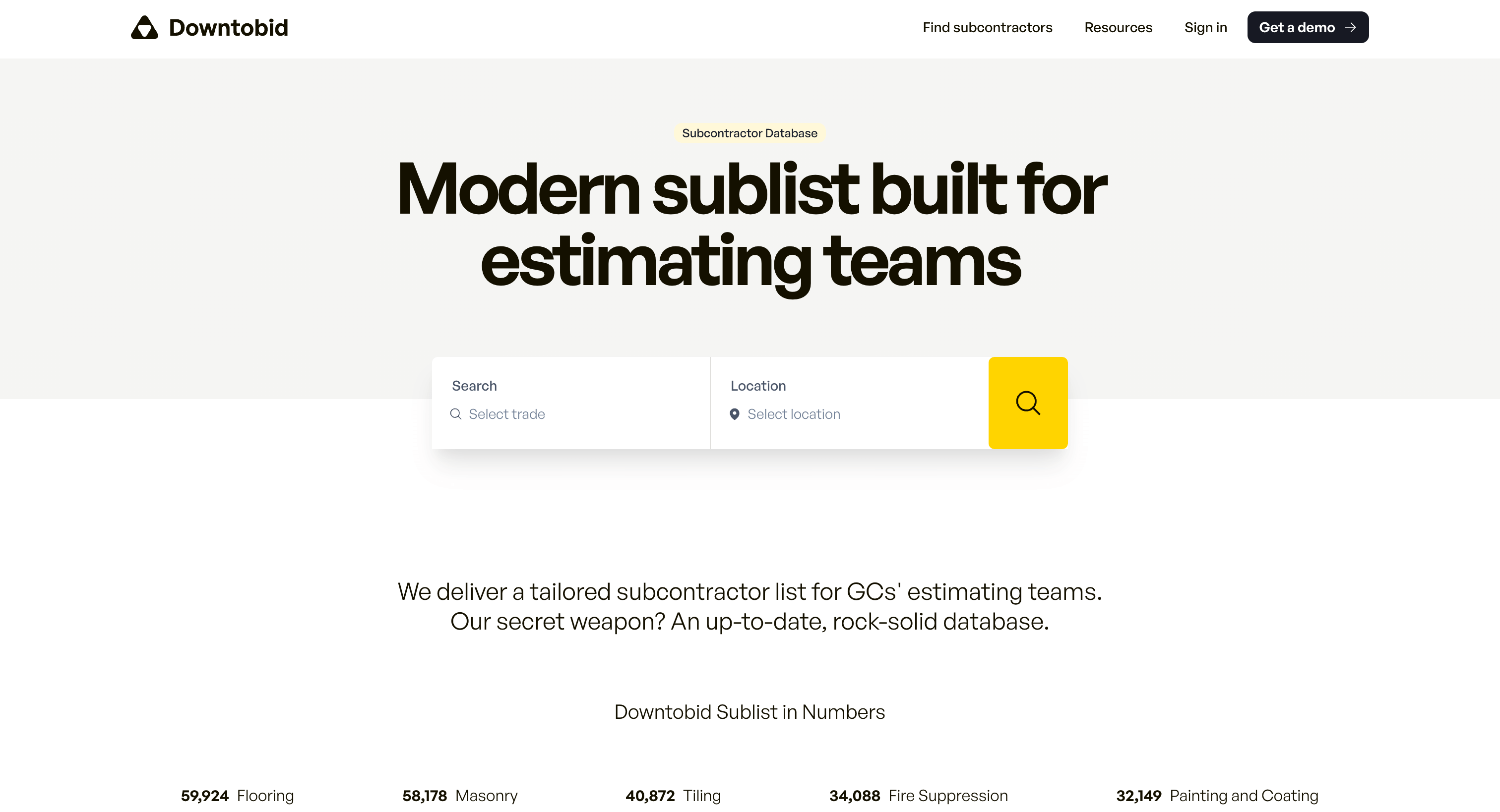
Why Downtobid’s Verified Subcontractor Network is the Best Choice To Find Subcontractors
Finding reliable, qualified subcontractors can be one of the most challenging aspects of managing a construction project. With countless variables at play—mostly outdated contact information—traditional methods of building a subcontractor list often fall short. That’s where the Downtobid Network comes in, offering a revolutionary solution to simplify your subcontractor invitation process. Here’s why our software's network should be your go-to platform for finding and inviting subcontractors to bid.
Comprehensive Multi-Step Verification Process
Our goal is to provide you with not just any list of subcontractors but a verified, reliable network that you can count on to reply. We’ve developed a multi-step verification approach to ensure you’re reaching the right people every time. Here’s how we do it:
Subcontractor Mapping
At the core of Downtobid’s powerful platform is its ability to map out the subcontractor landscape across the entire U.S. We leveraged AI to find subs across the nation. We started by creating a comprehensive list of the most common trades required for construction projects and then mapped every zip code in the nation to build a massive database of subcontractors. If a subcontractor had an online presence—whether through a website, directory listing, or any other digital footprint—our system would find it. The result? A large, nationwide list of subcontractors spanning every trade and region.
This extensive mapping ensures that our database includes practically every subcontractor in the country, making it the most exhaustive resource for general contractors looking to find the right professionals for their projects.
Automated Data Verification
However, having a massive list of subcontractors is just the start. An unfiltered list is often riddled with outdated information, incomplete data, or even irrelevant contacts (e.g., manufacturer representatives instead of actual subcontractors). To make this data useful for bidding and outreach, we had to ensure it was clean, accurate, and actionable.
To tackle this, we developed a highly sophisticated web-scraping tool that automates the verification process. This tool visits each subcontractor’s website and extracts crucial information, including:
- Trades performed
- Areas of operation
- MWBE status (Minority- and Women-Owned Business Enterprises)
- Union or non-union affiliation
- Average project size
- Past project experience
- Key decision-makers (emails & phone numbers)
- Phone numbers and estimating emails
By using machine learning and natural language processing, we predict the subcontractor’s trade based on the content of their website. For example, if the word "electrical" frequently appears on a homepage, our system automatically identifies the company as an electrical subcontractor. Additionally, we scan for keywords like "MWBE" or "union" to provide even more detailed classifications.
This automated data verification ensures that the subcontractor list is precise and up-to-date, saving you time and effort while improving the accuracy of your bid outreach.
Direct Decision Maker Contacts
Once we had a clean, verified list of subcontractors, the next challenge was identifying the right contact person at each company. Most subcontractor websites only provide generic emails like info@subcontractor.com, which rarely results in a timely response when sending bid invitations. We knew that to improve response rates, we needed to reach the chief estimator or decision-maker directly.
To solve this, Downtobid’s system goes beyond scraping basic contact details and digs deeper to uncover the direct emails and phone numbers of key decision-makers, particularly those responsible for estimating. This way, when you send out a bid invitation, it’s going straight to the person who can make decisions, significantly increasing the likelihood of a response.
Tailored Subcontractor Lists Based on Your Project Needs
One of the most powerful features of Downtobid is its ability to generate tailored subcontractor lists based on your project’s specific scope of work, location, and trade requirements. Here’s how:
AI-Powered Scope Matching
Downtobid’s AI reads your construction plans and automatically identifies the different trades required, from plumbing and electrical to HVAC and drywall.
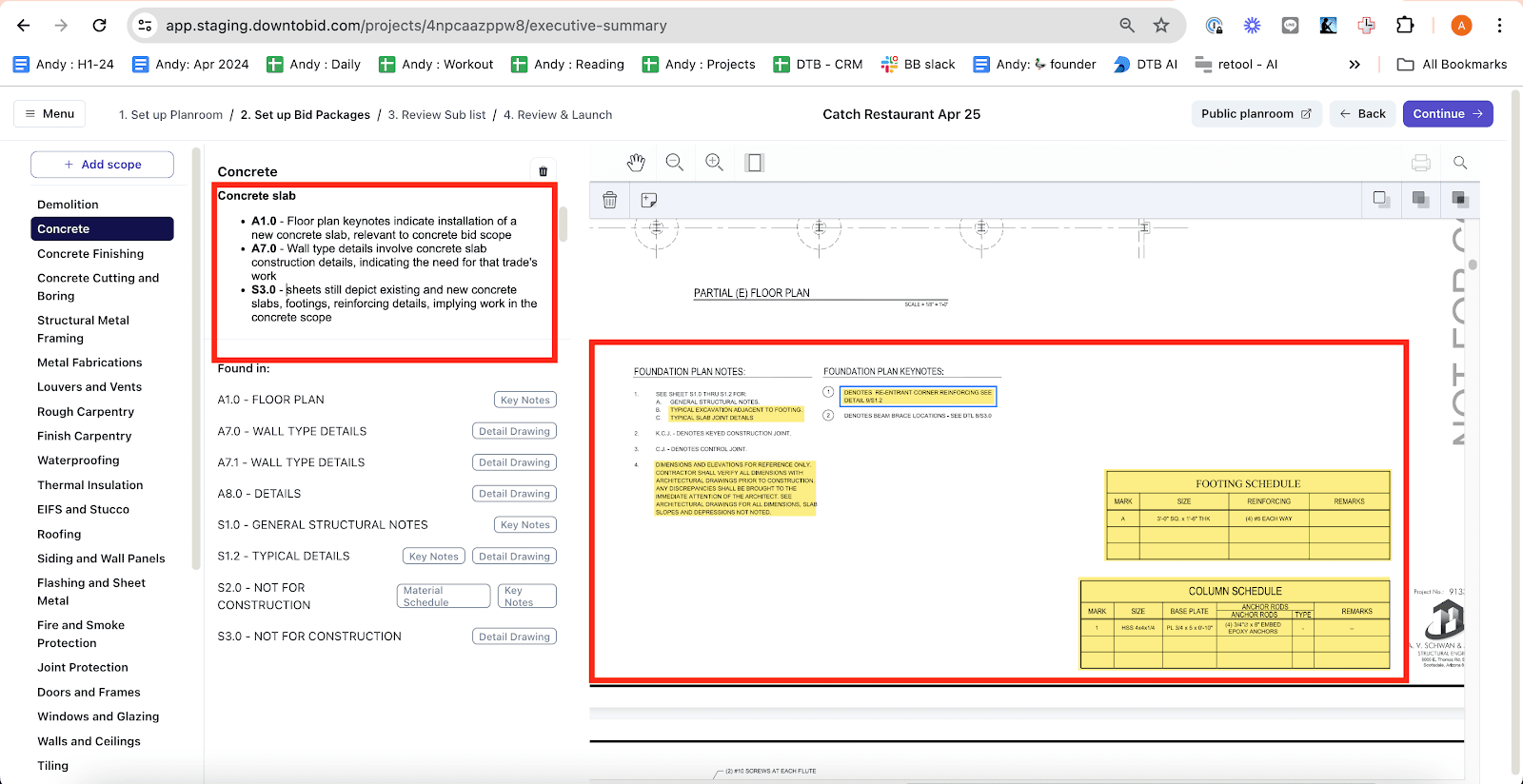
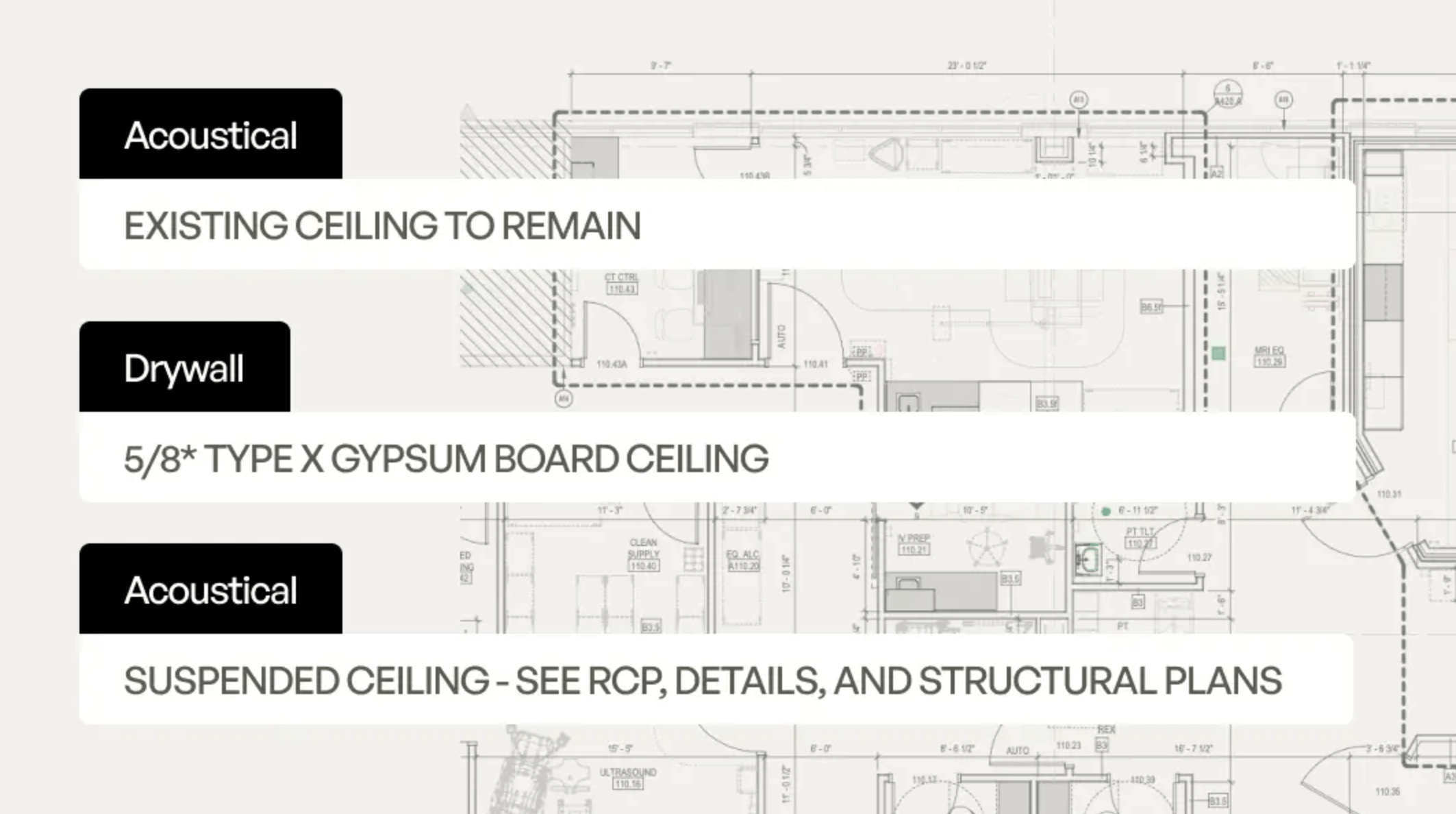
The platform then matches these needs with qualified subcontractors in your area.
Location-Specific Searches
Whether your project is in a major city or a small town, Downtobid’s database covers subcontractors across the nation, allowing you to find local professionals who are familiar with your region’s regulations and market.
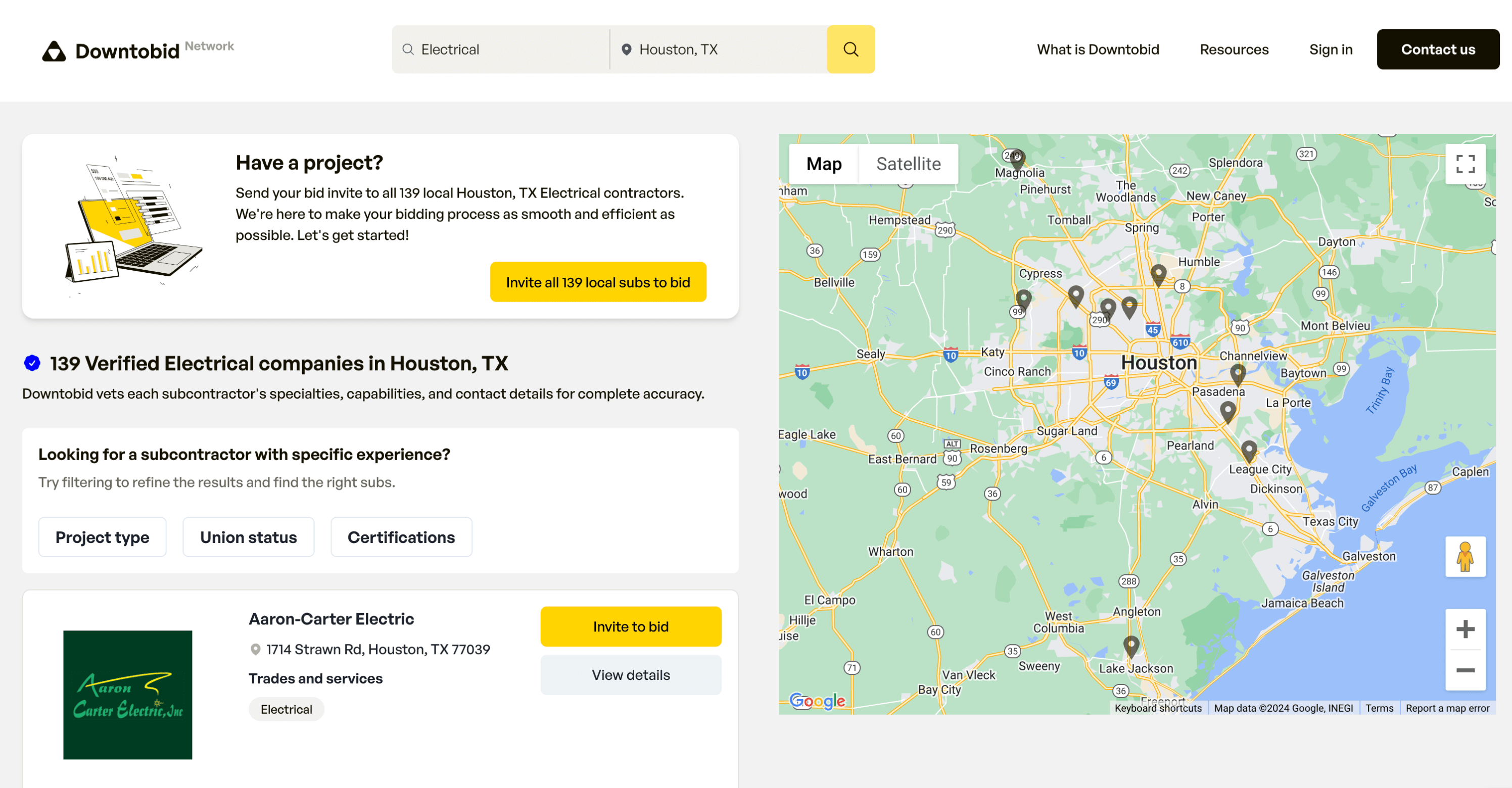
Trade-Specific Recruitment
Downtobid doesn’t just give you a general list of subcontractors—it provides trade-specific suggestions, ensuring you’re only reaching out to subcontractors who specialize in the exact work your for your project requirements.
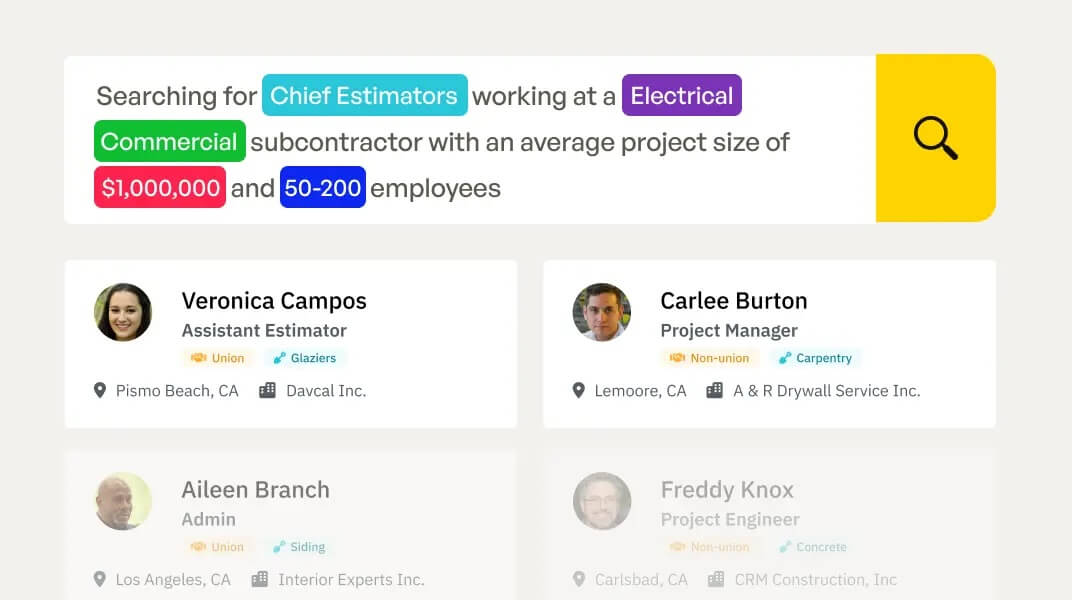
Personalized Bid Invitations for Increased Engagement
One of the most frustrating aspects of traditional bid platforms is the impersonal nature of invitations to bid (ITBs), which often result in poor response rates. Downtobid solves this issue with personalized bid invitations that speak directly to the subcontractor’s trade and project needs.
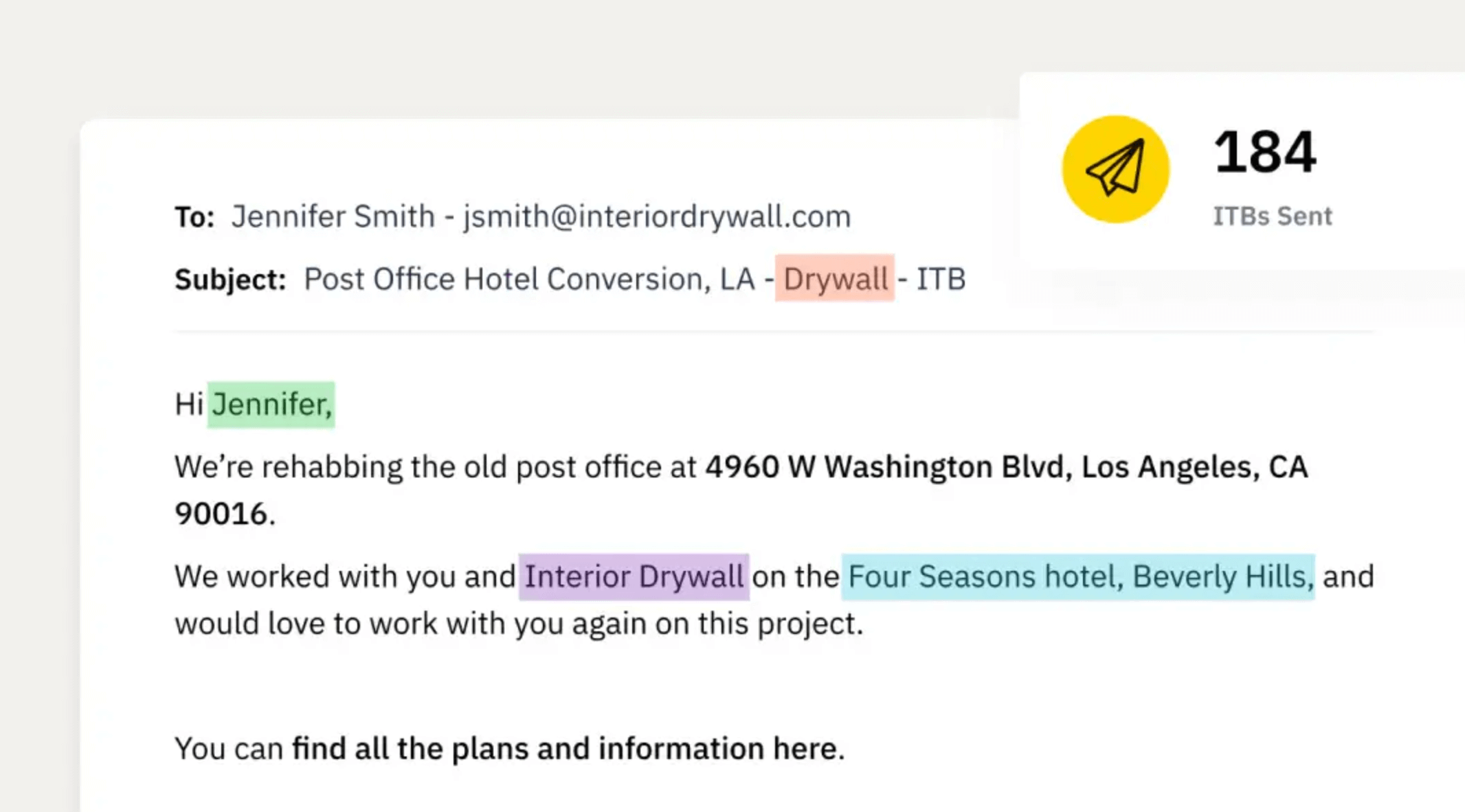
Tailored Invitations
By including specific project details such as location, scope, deadlines, and budget, Downtobid’s system sends out personalized invitations that are more likely to capture a subcontractor’s attention. This approach has been shown to increase response rates by 30% on average.
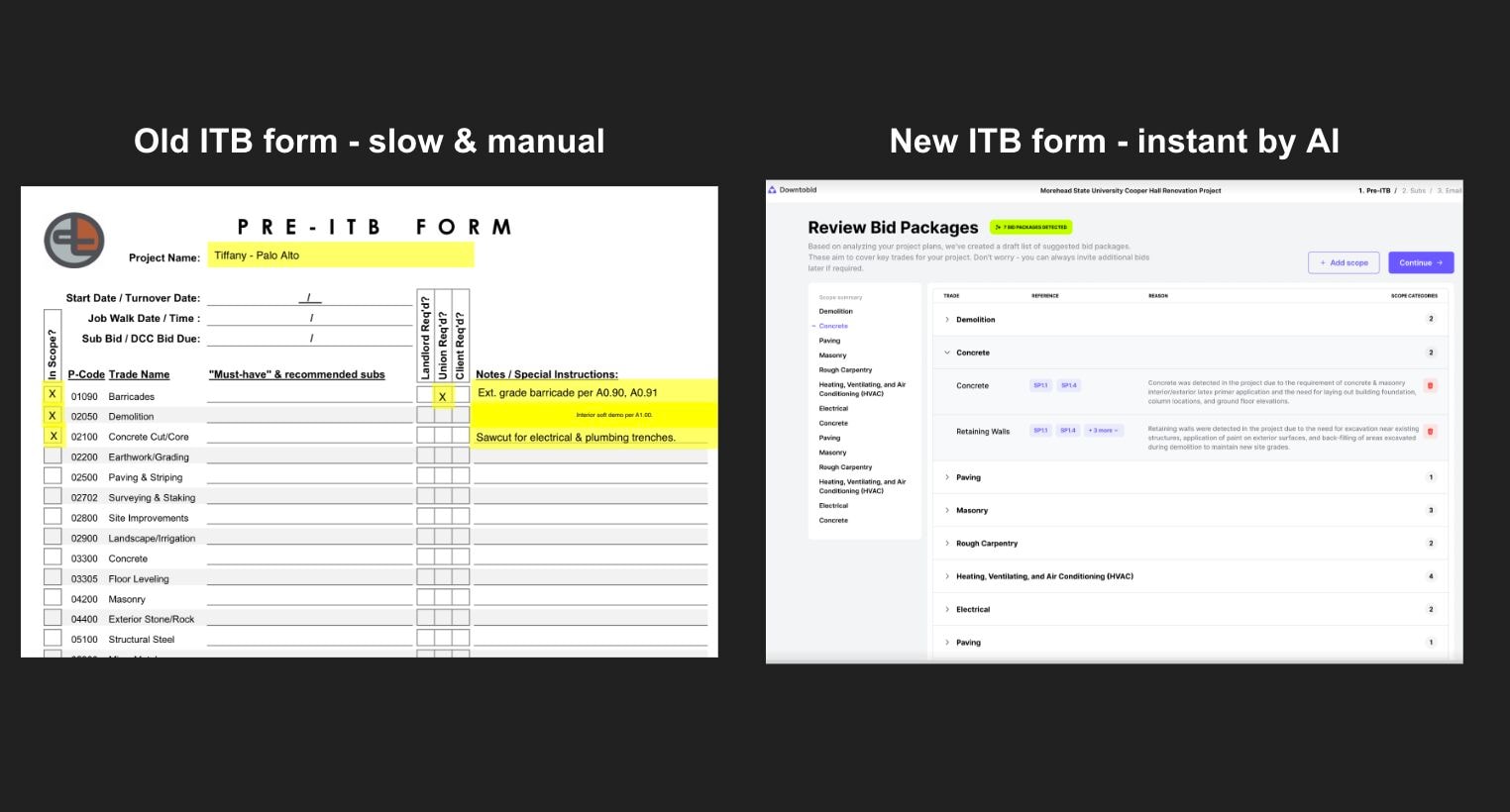
Scope Clarity
Our software ensures that each bid invitation includes a summary of the specific scope of work relevant to the subcontractor, reducing confusion and ensuring accurate bids from the start.
Real-Time Communication
Subcontractors can respond quickly through the platform, allowing general contractors to receive bids faster and make decisions more efficiently.
Better Collaboration with Subcontractors through Downtobid’s Planroom
Clear communication and access to project documentation are critical for a smooth working relationship with subcontractors. Downtobid’s Planroom makes it easy for subcontractors to access relevant project documents and ensures that everyone is on the same page.
Document Categorization
The Planroom organizes all project documentation—plans, specifications, photos, and more—into easy-to-navigate categories. Subcontractors can quickly find trade-specific files, reducing miscommunication and errors.
Real-Time Updates
As changes are made to the project, subcontractors are notified in real-time, allowing them to adjust their bids or work schedules as necessary. This feature prevents costly delays caused by miscommunication or outdated information.
Collaboration Tools
The Planroom allows for seamless collaboration between general contractors and subcontractors, facilitating quick feedback, questions, and clarifications.
Faster and More Reliable Bid Responses
One of the most significant pain points for general contractors is waiting for bid responses from subcontractors. Downtobid’s Verified Subcontractor Network helps solve this problem by ensuring that you’re reaching out to qualified and engaged subcontractors who are more likely to respond.
- Verified Contacts: Downtobid’s subcontractor list isn’t just large—it’s carefully curated and verified, meaning you can trust that the subcontractors you’re reaching out to are active and ready to work.
- Boosted Response Rates: Thanks to the platform’s personalized bid invitations and AI-powered scope summaries, general contractors see higher response rates and faster turnaround times, reducing the time spent waiting for bids and increasing the overall efficiency of the hiring process.
How Do You Hire Subcontractors? Ultimate Independent Contractor Checklist
Hiring subcontractors for a construction project can be a complex task, but by following a structured process you can ensure that you select the right professionals for the job. Below is a checklist to help you navigate the hiring process efficiently.
Identify the Scope of Work
Before you start searching for subcontractors, it’s crucial to clearly define the specific tasks and trades required for your project. Break down the overall project into smaller scopes of work (e.g., plumbing, electrical, HVAC, drywall) so you can target subcontractors who specialize in each trade.
Use project management software or tools like ours to automatically detect project scopes from your construction plans, saving time and ensuring you don't miss any key trades.
Create a Subcontractor List
Once you know what trades you need, the next step is to create a list of potential subcontractors. You can do this by using subcontractor directories, professional networks, or platforms like Downtobid, which offers a Verified Subcontractor Network. Downtobid simplifies this process by providing a curated list of qualified subcontractors in your area, ensuring they meet the trade requirements for your project.
Unlike traditional methods, our software keeps its subcontractor database up-to-date with verified contact information, ensuring you get accurate data and avoid wasting time on outdated leads.
Review Qualifications and Experience
After generating a list of potential subcontractors, it’s time to evaluate their qualifications. Look for subcontractors with the appropriate licenses, insurance, and relevant project experience. Don’t hesitate to ask for portfolios or examples of past work, especially for projects similar to yours. Look carefully at the subcontractor's qualifications for quality assurance.
Conduct Interviews and Request Quotes
Once you’ve narrowed down your list, set up interviews with the subcontractors to discuss the project in detail. During the interview, ask them about their availability, project timelines, and how they handle unforeseen issues. Additionally, request a detailed quote for the work, including labor and materials.
Downtobid streamlines this step by enabling personalized bid invitations, which can significantly increase response rates and help you secure competitive quotes faster.
Verify Insurance and Compliance
Before moving forward with any subcontractor, verify that they have the necessary insurance coverage (e.g., general liability and workers’ compensation). Ensure that they maintain compliance with local regulations, safety standards, and any other construction industry-specific requirements.
Always request copies of insurance certificates and verify their validity before signing any contracts.
Negotiate Contracts and Terms
Once you’ve chosen your subcontractors, negotiate the terms of the contract. Ensure the contract outlines the scope of work, payment schedule, deadlines, and any penalties for delays. Be clear about how changes or additional work will be handled.
Use a standardized, comprehensive contract template to ensure all legal aspects are covered, including warranties, dispute resolution, and termination clauses. Come together to discuss and agree on the overall project timeline.
Finalize Payment Terms
Agree on a payment structure that works for both parties. This could be based on project milestones, a percentage of completion, or a fixed schedule. Include provisions for retainage (a percentage withheld until project completion) to ensure the work is completed to your satisfaction.
Typical retainage in construction contracts ranges from 5% to 10%. This ensures that subcontractors complete their work before receiving full payment.
Establish a Communication Plan
Set up a clear communication strategy to stay in touch with your subcontractors throughout the project. Regular updates are crucial for tracking progress, addressing issues, and maintaining deadlines.
Downtobid offers a subcontractor-friendly Planroom, making it easy for subcontractors to access project documents, communicate efficiently, and stay organized without having to create an account.
What is Required for Subcontracting?
Hiring subcontractors for a construction project involves more than just finding skilled workers. You need to ensure that subcontractors meet specific legal, financial, and safety requirements. This section outlines the key elements that every general contractor should verify before onboarding subcontractors for any project.
Legal Requirements
The first and most crucial requirement is ensuring that the subcontractor meets all legal obligations. This includes having the proper licensing, permits, and certifications to operate within your region.
Licensing
Verify that your subcontractor holds the appropriate trade licenses for the work they will perform. Licensing requirements vary by State and trade, so it’s essential to ensure that your subcontractors are compliant with local laws. For example, an electrician should have an electrical contractor’s license and meet any additional requirements, such as bonding and insurance, depending on the state or city.
Permits
Depending on the scope of work, subcontractors may need specific permits to operate legally. Ensure that your subcontractors are familiar with the necessary permits and have the experience to secure them efficiently.
Contractor Agreements
Before starting any work, you need a legally binding contract that outlines the scope of work, deadlines, payment terms, and other key conditions. This contract should also include provisions for how changes to the scope will be handled and how disputes will be resolved. Ensure all legal documents are in place, including tax forms like the W-9, proof of insurance, and a signed contract or subcontractor agreement. This checklist is essential for ensuring that your subcontractors are classified correctly as independent contractors and not employees.
Insurance and Bonding
Insurance and bonding are non-negotiable when hiring subcontractors. These protect both the general contractor and the client from financial risk and liability in case of accidents, damage, or a failure to complete the work.
General Liability Insurance
The subcontractor should carry general liability insurance to cover bodily injury, property damage, and legal costs. This is crucial for protecting you from lawsuits and unexpected liabilities.
Workers' Compensation Insurance
If the subcontractor has a team or crew, they should also carry workers' compensation insurance to cover any injuries that occur on the job site. This protects both the subcontractor and the general contractor from liability claims.
Performance and Payment Bonds
For larger projects, it’s often necessary to require subcontractors to provide performance and payment bonds. A performance bond ensures that the subcontractor will complete the work as agreed, while a payment bond guarantees that the subcontractor will pay their suppliers and workers. Always request copies of insurance certificates and bond documents. Make sure they are valid and cover the entire duration of the project.
Financial Stability
Subcontractors need to have the financial stability to handle the project from start to finish without delays. Financially unstable subcontractors can cause significant disruptions, from delayed material purchases to incomplete work.
- Credit Checks: Consider running a credit check or requesting financial statements to ensure that the subcontractor is in good financial standing. This step helps reduce the risk of project delays due to cash flow issues.
- Payment Terms: Discuss and agree on payment terms upfront. Subcontractors should be able to manage their cash flow throughout the project, even if payments are staggered or milestone-based. Including a retainage clause (5-10%) in the contract is a standard practice to ensure subcontractors complete the work satisfactorily before receiving full payment.
Safety Certifications and Compliance
Safety is one of the most important considerations on any construction site. You need to ensure that subcontractors follow all safety regulations, both to protect workers and to avoid delays due to accidents or compliance issues.
OSHA Compliance
The Occupational Safety and Health Administration (OSHA) sets safety standards for construction projects. Ensure that your subcontractors are OSHA-compliant and have the necessary safety certifications for their trade.
Safety Training and Certifications
Subcontractors should provide proof of safety training for their crew members. This might include certifications like OSHA 10 or OSHA 30, depending on the nature of the work.
Site Safety Plans
For larger projects, subcontractors may need to submit a site-specific safety plan detailing how they will ensure safe working conditions, including the use of personal protective equipment (PPE) and fall protection.
Subcontractor References and Reputation
Before hiring a subcontractor, it’s critical to verify their reputation within the industry. Request references from previous projects and review their past work to ensure they can deliver the quality and reliability your project requires.
Request References
Ask the subcontractor for contact information from several past clients, ideally from projects similar to yours. Follow up with these references to get a sense of the subcontractor’s reliability, communication style, and quality of work.
Online Reviews and Ratings
Look for online reviews on industry-specific platforms or even general review sites like Google or Yelp. Pay attention to patterns in the feedback, such as consistent issues with meeting deadlines or poor communication.
Why Use Downtobid’s Verified Network for Subcontracting?
Downtobid helps streamline the hiring process by offering a Verified Subcontractor Network that meets all the above requirements. Here’s why Downtobid is the best choice for general contractors:
- Comprehensive Verification: Every subcontractor in Downtobid’s network is thoroughly verified before being added to the database.
- Up-to-Date Information: Unlike other platforms that may have outdated or incomplete information, Downtobid ensures that all subcontractor details are current, reducing the risk of communication issues or unreliable bids.
- Improved Bid Response Rates: Downtobid’s platform allows you to send personalized bid invitations, which leads to higher response rates from subcontractors. This means you get more accurate and timely bids, helping you keep your project on track.
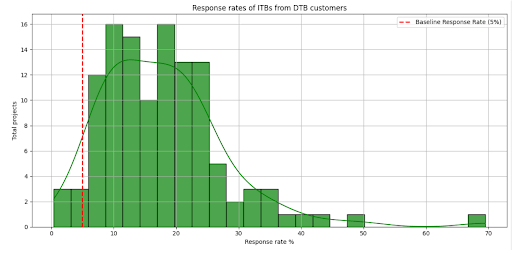
Detailed Onboarding Checklist: Setting Your Project Up for Success
A well-executed subcontractor hiring process forms the backbone of every successful commercial construction project. Through this guide, you've gained the essential knowledge needed to find, evaluate, and simplify the onboarding process and find qualified subcontractors who can deliver results. The steps we've covered—from insurance verification to contract negotiation - create a framework that protects your interests and sets clear expectations from day one.
Taking shortcuts during the hiring process often leads to expensive mistakes and project delays. Invest the time upfront to verify credentials, contact references, and create detailed agreements. These actions build the foundation for strong subcontractor relationships and smooth project execution.
Tools like Downtobid's Verified Subcontractor Network can streamline many aspects of subcontractor selection, but the core principles remain the same: maintain high standards, document everything, and communicate expectations clearly. Following this systematic approach will help you consistently find reliable subcontractors who can execute your vision.
Try a free demo here.